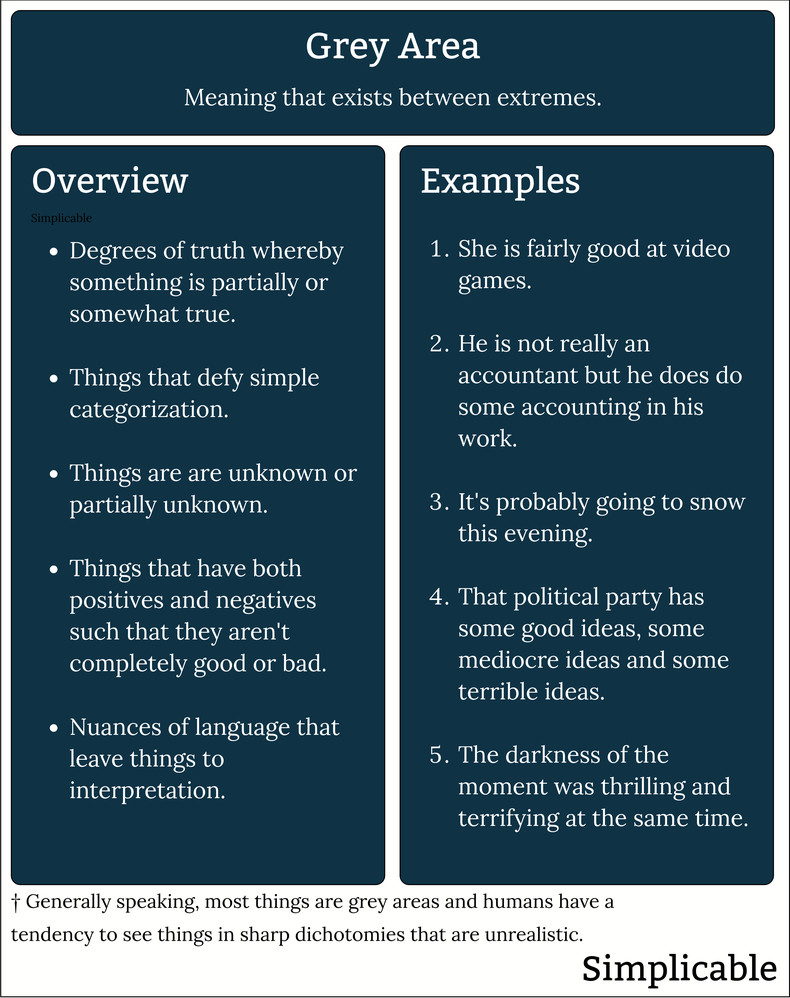
Degrees
It is very common for there to be degrees of truth that exist between extremes. For example, a price can be expensive or cheap. However, there are many grey areas between these two such as an item that was a reasonable price, a good value or somewhat expensive.Uniqueness
Grey areas exist where things defy categorization because they are unique. For example, a boat that is similar to both a canoe and a kayak without technically conforming to either category.Ambiguity
Another primary reason that grey areas occur is that information is often ambiguous such that certain things are unknown. For example, a new hire may be given a job description that makes certain responsibilities somewhat unclear. This may be done intentionally to prepare the individual for the dynamic and ever changing nature of the role.Nuance
Languages include large vocabularies and complex grammatical structures because people commonly want to express exactly what they feel or think with significant detail known as nuance. For example, a person may describe their dog as "spirited and protective." This conveys nuanced information that is somewhat grey.Creativity
People use language creatively to spark the imagination as opposed to communicating precise and specific information. For example, Edgar Degas said "only when he no longer knows what he is doing does the painter do good things." This may be good advice for aspiring artists but its meaning is a grey area that is open to broad interpretation.Complex Systems
Grey areas exist where systems are too complex to completely model. For example, scientists may believe that the extinction of one species in a forest will put other species at risk of extinction but may be unable to fully confirm this theory due to the overwhelming complexities of the ecosystem.Saving Face
People may criticise others with subtleties that allow the individual to save face. This may be less precise than direct criticism and often represents a grey area. For example, "this coffee is good, I don't think I've ever had a coffee so strong before, it really wakes you up." This may be a face saving way to say "this coffee is terrible because you made it too strong." Alternatively, the person may really appreciate your strong brew. In cultures where saving face is common, people learn to read subtleties to reduce such grey areas.Principles
It is common for advice, principles and guidelines to be framed such that they are open to interpretation in each situation. This is often more helpful, realistic and fair than a system of precise rules. For example, the Golden Rule is a maxim found in many religions and cultures that is sometimes stated as "treat others as you would want to be treated."Systems, Processes & Procedures
Well designed systems, processes and procedures are designed to allow for grey areas. For example, an airline that makes exceptions for special cases in all of their policies may receive far less bad press than an airline with rigid rules that are always strictly followed whatever the conditions and circumstances.Probabilities
Probabilities are a mathematical way to deal with grey areas in the form of uncertainty. For example, if there is a 30% chance of rain then it might rain but it's not too likely.Logic
Traditional systems of logic are based on the principle of excluded middle that states that things are either true or false. This makes a system of logic easier to implement, particularly before computers were available. A more modern form of logic known as Fuzzy logic represents areas between true and false as probabilities. This is far more precise and useful for real world applications. For example, traditional logic would find that it is either true or false that a road is slippery. Fuzzy logic can be used model the conditions of the road with great precision such that it decides a road is "not slippery where level, mildly slippery on inclines of 5% slope and moderately slippery on inclines of greater than 7%."Artificial Intelligence
Artificial intelligence is often based on probability models that resemble fuzzy logic whereas traditional software is more likely to be based on true or false logic. Generally speaking, artificial intelligence is therefore more likely to handle grey areas. As such, AI is useful for handling domains such as image recognition, natural language processing and self-driving cars where there are many grey areas due to the real world conditions involved.Law
The legal systems of many nations give judges significant leverage in determining a sentence in recognition of the many degrees and extenuating circumstances that apply to each case. For example, if there is a law against using fireworks in a city there is a difference between lighting a small sparkler in your backyard and setting off a series of large 30 pound shells in a crowded park.Storytelling
Storytelling may use mystery to make things more interesting. It is also common to leave out boring details and to describe things in open and creative ways. This allows the audience to fill in the details with their imagination. For example, a MacGuffin is a literary device that leaves the motivation of a central character as a mystery. This is the driving force of the plot but is never explained.Art
Art also makes use of mystery such as ambiguity and allegory that take some interpretation such that people develop different impressions from the same work. For example, people tend to have very different impressions of Mona Lisa's expression, particularly her smile. This is considered intentional on the part of Leonardo da Vinci as the smile has a number of unusual characteristics. Her smile is slight, asymmetrical and shaded such that perceptions of the smile change with different viewing angles. It was quite unusual for smiles to appear in 16th century portraits and this remained uncommon until the 20th century.
Culture
Culture are elements of life that people value as a group. Culture emerges through shared experience and is filled with grey areas. For example, in Japan it is polite to loudly slurp noodles when you eat but it is unclear to what extent this applies to other foods. Some individuals feel this extends to all foods and will slurp things such as salads that most people eat quietly. As culture has no authoritative rule book, it is a somewhat open question whether or not this is rude.Propaganda & Groupthink
It is characteristic of propaganda, dogma and groupthink to present all issues as black and white and to deny the grey areas that complicate real world issues. For example, groupthink may label anyone who questions a group's ideology with terms that are analogous to good and evil, right and wrong. These oversimplifications are designed to shutdown the opposition to control the conversation.Summary
A grey area is the common situation where truth is complex, difficult to categorize or partially unknown.
| Overview: Grey Area | ||
Type | ||
Definition | Meaning that exists between two extremes. | |
Also Known As | gray area (American spelling) | |
Related Concepts | ||














































